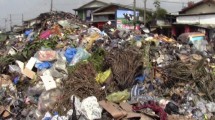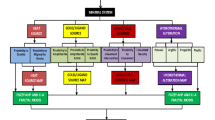Abstract
The appropriate site selection for waste disposal is one of the major problems in waste management. Also, many environmental, economical, and political considerations must be adhered to. In this study, landfill site selection is performed using the Geographic Information System (GIS), the Analytical Hierarchy Process (AHP), and the remote sensing methods for the Senirkent–Uluborlu Basin. The basin is located in the Eğirdir Lake catchment area, which is one of the most important fresh water in Turkey. So, waste management must be regulated in the basin. For this aim, ten different criteria (lithology, surface water, aquifer, groundwater depth, land use, lineaments, aspect, elevation, slope, and distance to roads) are examined in relation to landfill site selection. Each criterion was identified and weighted using AHP. Then, each criterion is mapped using the GIS technique, and a suitability map is prepared by overlay analyses. The results indicate that 96.3% of the area in the basin is unsuitable; 1.6%, moderately suitable; and 2.1%, most suitable. Finally, suitable regions in the basin are determined for solid waste landfill disposal and checked in the field. The selected and investigated regions are considered to be suitable for the landfill.
Similar content being viewed by others
References
Al Khalil, M. I. (2002). Selecting the appropriate project delivery method using AHP. International Journal of Project Management, 20, 469–474.
Allen, A., Brito, G., Caetano, P., Costa, C., Cummins, V., Donnelly, J., et al. (2003). The development of a GIS model for the location of landfill sites in Ireland and Portugal, Atlantic area. INTERREG-IIC Programme, Fil Project report, project ref. No. EA-B1IRE-No 2.15.
Banar, M., Köse, B. M., Özkan, A., & Acar, I. P. (2007). Choosing a municipal landfill site by analytic network process. Environmental Geology, 52, 747–751.
Basağaoğlu, H., Celenk, E., Mariulo, M. A., & Usul, N. (1997). Selection of waste disposal sites using GIS. Journal of American Water Resources Association, 33(2), 455–464.
Chaulya, S. K. (2003). Water resource development study for a mining region. Water Resources Management, 17, 297–316.
Ehler, G., Cowen, D., & Mackey, H. (1995). Design and implementation of a spatial decision support system for site selection. In Proceedings of ESRI international user conference (p. 100). Palm Springs, CA.
Erkut, E., & Moran, S. R. (1991). Locating obnoxious facilities in the public sector: An application of the hierarchy process to municipal landfill siting decisions. Socio-Economic Planning Sciences, 25(2), 89–102.
Gemitzi, A., Petalas, C., Tsihrintzis, V. A., & Pisinaras, V. (2006). Assessment of groundwater vulnerability to pollution: A combination of GIS, fuzzy logic and decision making techniques. Environmental Geology, 49, 653–673.
Karagüzel, R., Özçelik, H., Mutlutürk, M., Güldal, V., Tokgözlü, A., Beyhan, M., et al. (2003). Investigation report on site selection and environmental impact for solid waste of Manavgat–Antalya Municipality, Suleyman Demirel University, Turkey, unpublished report (pp 134).
Kontos, T. D., Komillis, D. P., & Halvadakis, C. P. (2003). Siting MSW landfills in Lesvos Island with a GIS based methodology. Waste Management and Research, 21(3), 262–277.
Kontos, T. D., Komilis, D. P., & Halvadakis, C. P. (2005). Siting MSW landfills with a spatial multiple criteria analysis methodology. Waste Management, 25, 818–832.
Lee, S. (2003). Evaluation of waste disposal site using the DRASTIC system in Southern Korea. Environmental Geology, 44, 654–664.
Lin, H. Y., & Kao, J. J. (1998). A vector-based spatial model for landfill siting. Journal of Hazardous Materials, 58, 3–14.
Lober, D. J. (1995). Resolving the siting impasse: Modeling social and environmental locational criteria with a geographic information system. Journal of American Planning Association, 61(4), 482–495.
Lucasheh, A. F., Droste, R. L., & Warith, M. A. (2001). Review of Expert System (ES), Geographical Information System (GIS), Decision Support System (DSS) and their application in landfill design and management. Waste Management & Research, 19, 177–185.
Malczewski, J. (1997). Propagation of errors in multicriteria location analysis: A case study. In G. Fandel & T. Gal (Eds.), Multiple criteria decision making (pp. 154–155). Berlin: Springer.
Mikkelsen, P. S., Häfliger, M., Ochs, M., Jacobsen, P., Tjell, J. C., & Boller, M. (1998). Pollution of soil and groundwater from infiltration of highly contaminated stormwater: A case study. Water Science and Technology, 36(8–9), 325–330.
Ministry of Environment and Forestry of Turkey (1991). Turkish regulations of the control of solid wastes. Official Gazzette, No. 20814, Ankara, Turkey.
Mummolo, G. (1996). An analytic hierarchy process model for landfill site selection. Journal Environmental Systems, 24(4), 445–465.
Mutlutürk, M., & Karagüzel, R. (2007). The landfill area quality (LAQ) classification approach and its application in Isparta, Turkey. Environmental and Engineering Geoscience, 13, 229–240.
Muttiah, R. S., Engel, B. A., & Jones, D. D. (1996). Waste disposal site selection using GIS based simulated annealing. Computers & Geosciences, 22(9), 1013–1017.
Nas, B., Cay, T., Iscan, F., & Berktay, A. (2008). Selection of MSW landfill site for Konya, Turkey using GIS and multi-criteria evaluation. Environmental Monitoring Assessment, 160(1–4), 491–500.
Rezaei-Moghaddam, K., & Karami, E. (2008). A multiple criteria evaluation of sustainable agricultural development models using AHP. Environment, Development and Sustainability, 10, 407–426.
Saaty, T. L. (1980). The analytic hierarchy process (p. 287). New York: McGraw-Hill.
Sarptaş, H., Alpaslan, M. N., & Dolgen, D. (2005). GIS supported solid waste management in coastal areas. Water Science and Technology, 51(11), 213–220.
Sener, E., Davraz, A., & Özçelik, M. (2005). An integration of GIS and remote sensing in groundwater investigations: A case study in Burdur, Turkey. Hydrogeology Journal, 13, 826–834.
Sener, B., Süzen, M. L., & Doyuran, V. (2006). Landfill site selection by using geographic information systems. Environmental Geology, 49, 376–388.
Sener, E., Şener, Ş., & Davraz, A. (2009). Assessment of Aquifer Vulnerability in the Lake Basin Based on GIS and DRASTIC Method: A case study of Senirkent–Uluborlu (Isparta-Turkey) Basin. Hydrogeology Journal, 17(8), 2023–2035.
Siddiqui, M., Everett, J., & Vieux, B. (1996). Landfill siting using geographic information systems: A demonstration. Journal of Environmental Engineering, 122(6), 515–523.
Simşek, C., Kıncal, C., & Gündüz, O. (2005). A solid waste disposal site selectin procedure based on groundwater vulnerability mapping. Environmental Geology, 49, 620–633.
Solnes, J. (2003). Environmental quality indexing of large industrial development alternatives using AHP. Environmental Impact Assessment Review, 23(3), 283–303.
Tay, S. (2005). Geologic and geotechnical investigation of Senirkent–Uluborlu Basin aimed at solid waste landfill site selection (96 pp.). Master thesis, Suleyman Demirel University, Science Institute, Turkey.
Waele, J. De., Nyambe, I. A., Gregorio, A. Di., Gregorio, F. Di., Simasiku, S., Follesa, R., et al. (2004). Urban waste landfill planning and karstic groundwater resources in developing countries: The example of Lusaka (Zambia). Journal of African Earth Sciences, 39(3–5), 501–508.
Xu, J. H. (2002). Mathematical methods in contemporary geography. Beijing: China Higher Education Press.
Yagoub, M., & Buyong, T. (1998). GIS applications for dumping site selection. In Proceedings of the ESRI international user conference (p. 107). San Diego, USA.
Yeşilnacar, M. İ., & Cetin, H. (2005). Site selection for hazardous wastes: A case study from the GAP area, Turkey. Engineering Geology, 81, 371–388.
Yeşilnacar, M. İ., & Cetin, H. (2007). An environmental geomorphologic approach to site selection for hazardous wastes. Environmental Geology, 55(8), 1659–1671.
Ying, X., Guang-Ming, Z., Gui-Qiu, C., Lin, T., Ke-Lin, W., & Dao-You, H. (2007). Combining AHP with GIS in synthetic evaluation of eco-environment quality—A case study of Hunan Province, China. Ecological Modelling, 209(2–4), 97–109.
Author information
Authors and Affiliations
Corresponding author
Rights and permissions
About this article
Cite this article
Şener, Ş., Sener, E. & Karagüzel, R. Solid waste disposal site selection with GIS and AHP methodology: a case study in Senirkent–Uluborlu (Isparta) Basin, Turkey. Environ Monit Assess 173, 533–554 (2011). https://doi.org/10.1007/s10661-010-1403-x
Received:
Accepted:
Published:
Issue Date:
DOI: https://doi.org/10.1007/s10661-010-1403-x




